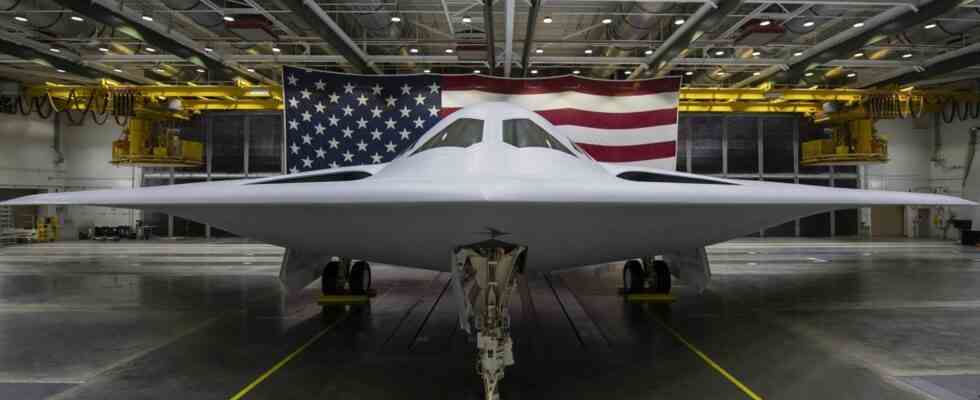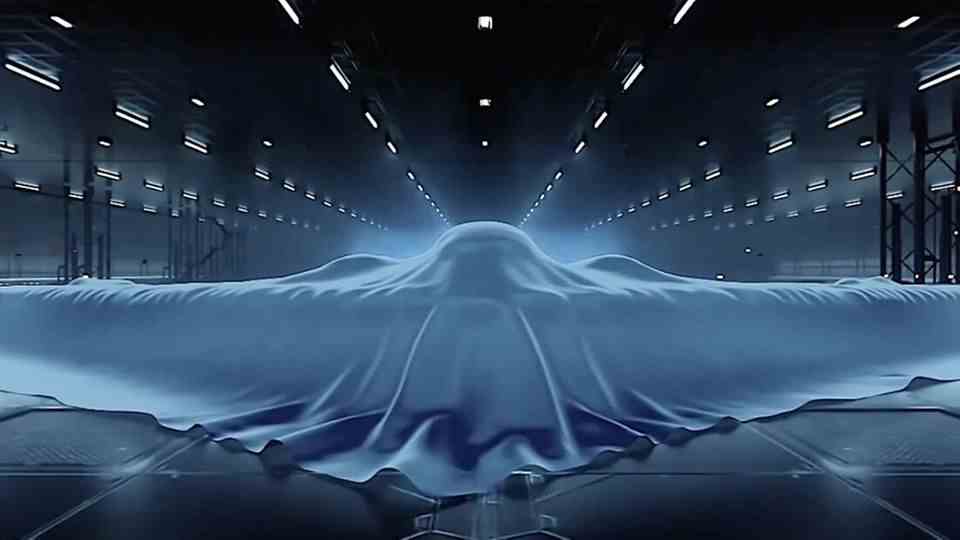Raider Rollout
B-21 Raider – that’s why the world’s most advanced bomber got such a lousy premiere
The narrow inlets on the top are interesting.
© Commons
The B-21 Raider bomber is set to become the USA’s new high-flyer. Loaded with electronics, it can penetrate undetected into areas protected by strong anti-aircraft defenses. But at the premiere more was hidden than shown.
On December 2nd, the US Air Force showed the new uber aircraft for the first time: the B-21 Raider. Previously, only renderings of the program were available. Now it was time to see Bomber “in person” at Northrop Grumman’s historic Plant-42 in Palmdale, California. But there wasn’t much to discover at the premiere. The bomber looked out of focus, lost in backlight, the light was turned into an aureole by a smoke machine. There were no other perspectives than from the front. Close-ups and an all-round tour with the camera – all non-existent.
The best and most expensive plane of all time got the shittiest premiere, some wondered. There is a reason for that. If the military had their way, you probably wouldn’t see the super bomber at all. Because of the enormous cost of the program alone, this wish is illusory. Given the billions being devoured by the B-21 program, the public must also be offered a real bomber. Renderings and cardboard models are not enough.
Nevertheless, one should only be able to recognize as little as possible. Because with a stealth bomber, the outer form reveals more secrets than the designers would like. Visitors had to hand in all cameras and smartphones, the bomber stayed under the roof of the hangar so that satellites could not pick it up.
Tell nothing if possible
Some things cannot be seen from the outside. About the performance of the electronic system. Like the F-35, the B-21 bomber should also be capable of integrated electronic warfare. This means that the aircraft is not a lone fighter, its sensors and systems work in conjunction with other weapons. The B-21 is a supercomputer that can also fly. It is a central building block in the Next Generation Air Dominance (NGAD) platform.
But even if you can’t estimate the electronics with a video, experts will be able to see the location of possible sensors under the skin of the jet.
How invisible is stealth technology?
“Stealth” means “hidden”, this ability is often described with words like “stealth bomber”. In fact, “stealth” initially only means one thing: Conventional radar systems can only detect a stealth jet with difficulty because its radar cross-section has been greatly reduced. Translated this means: The bomber reflects very few radar beams, as much as a much smaller object. Two factors contribute significantly to the small shadow. On the one hand, surfaces are covered with a special coating. For this reason, during the Second World War, submarine snorkels were covered with rubber. Today it is a material whose molecules react to radar beams by changing their state, thus “swallowing” the waves and hardly reflecting anything back. The capabilities of the coating can hardly be determined visually during the presentation. But the second factor is completely different: the shape of the jet, which is chosen so that it hardly reflects. And this shape can be seen from the outside with cameras.
Second World War
The Horten Ho 229 – the most mysterious plane of the Nazis
What was seen corresponded to the official renderings already shown. The Raider is significantly smaller than the B-2 Spirit and has smoother contours. The B-21 bomber has narrow cockpit windows, very small engine intakes. With smaller external dimensions, the room is comparatively very spacious.
Flying wing design
Like all stealth bombers, the B-21 bomber has the form of a so-called flying wing. It goes back to machines from the Second World War. The Horton brothers designed boomerang-shaped aircraft of the H series, which was to become the Gotha Go 229 (or Horten Ho 229) jet fighter. However, wartime production did not progress beyond prototypes.
In a flying wing, the wings and fuselage form a unit and merge into one another without edges, and there is also no towering tail unit. These are the best stealth requirements, in order to keep the radar shadow small, there must be no corners or edges. In cross-section from the front, the B-21 Raider also resembles a falcon. Based on the shape of the fuselage and its size, experts can accurately estimate the power of the engines and the possible payload and bomb load of the machine.
An exact three-dimensional model of the bomber can easily be made from a video. It can then be used to determine the complex flow dynamics around the jet. The visual presentation provides all interested countries with a 3D model for the wind tunnel free of charge.
The air intakes and outlets of the engines are particularly “secret”. They are neuralgic points because they represent openings in the otherwise smooth surface of the bomber. Their size allows a lot of conclusions to be drawn about the engines and their performance and other tricks used by the designers. The air intakes are on top to hide them from the beam of ground-based radar systems. The B-21’s exhaust gases are cooled.
“Stealth” today means more than just a small radar cross section. The bomber should also be undetectable by methods other than radar. And that’s a big challenge, because despite the “magic cloak” the B-21 Raider is not “invisible” and can be seen optically like any other aircraft. The shape of the jet and the type of engines must therefore also suppress the heat signature of the gases emanating from the engines. Likewise, the bomber must try to pull as small an air vortex as possible behind it – the trace of which can be used to calculate its position. Ultimately, camouflage is an endless task. Sound, heat, vibrations, changes in the magnetic field – everything must be reduced so that the enemy cannot detect the bomber.
Numerous interested parties
And the measures that are intended to prevent something like this can be seen very well from the outside. That’s why neuralgic components are often covered – such as the drive of submarines when they are launched. The more complex variant would be to cleverly cover these components – such as the air intakes – with parts made of plastic, so that the bomber looks realistic to the layman – but still hides its true shape.
In any case, caution in the presentation makes sense. Numerous countries are working on stealth programs, including the potential adversaries of the US, but not only them. And the experts of all these states will carefully analyze the products of the US defense industry, which is still the leader in stealth technology, in order to improve their own projects.




